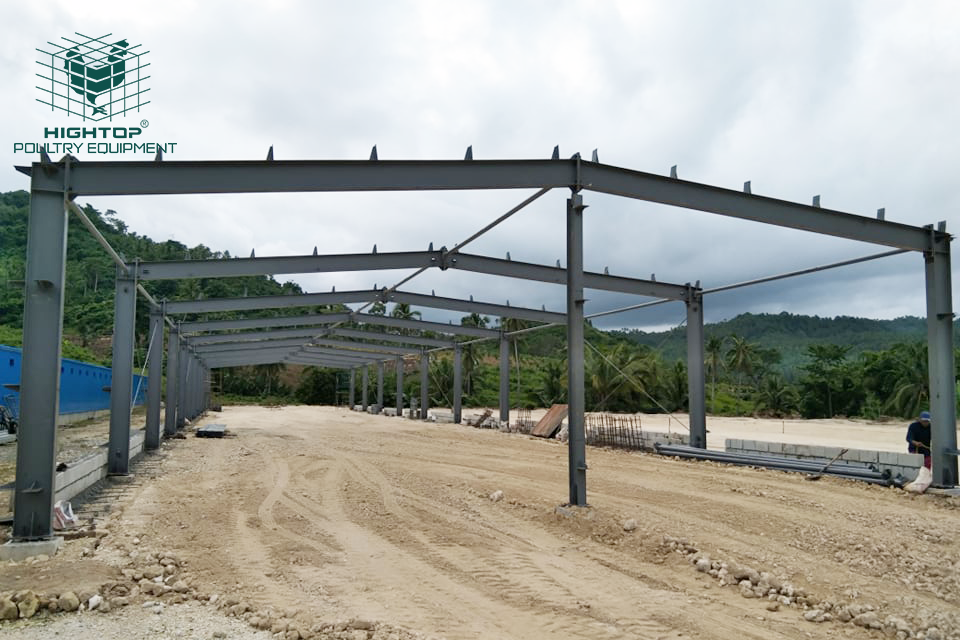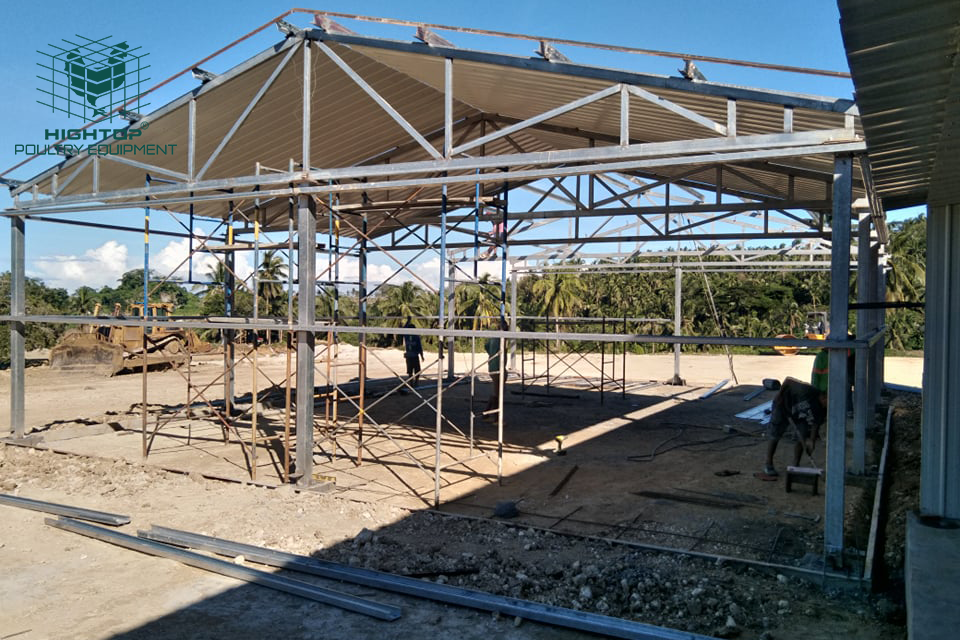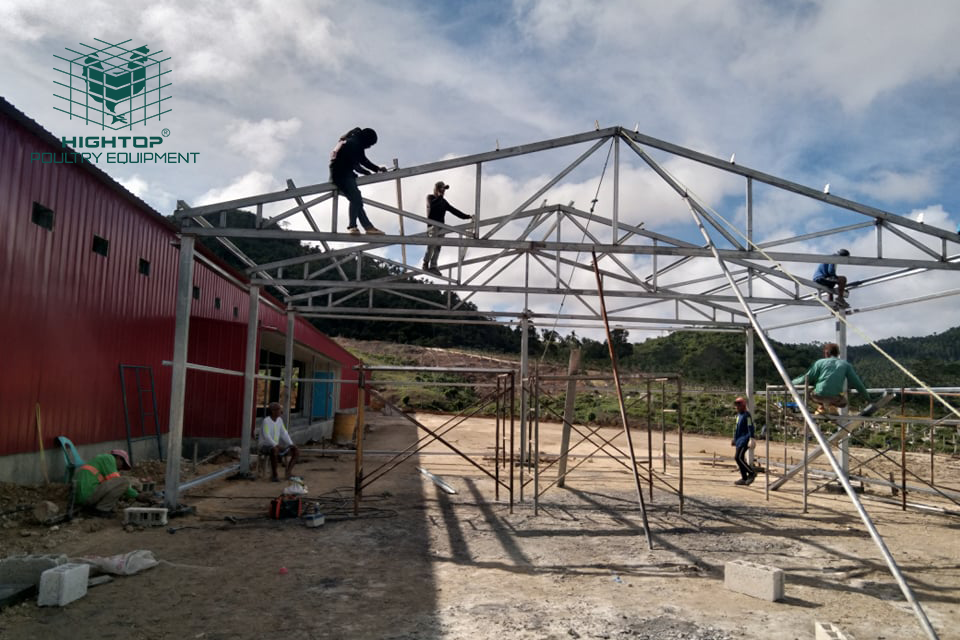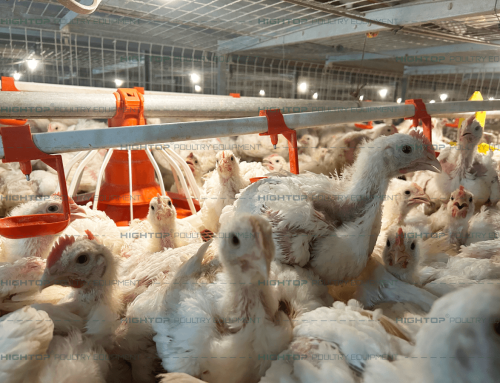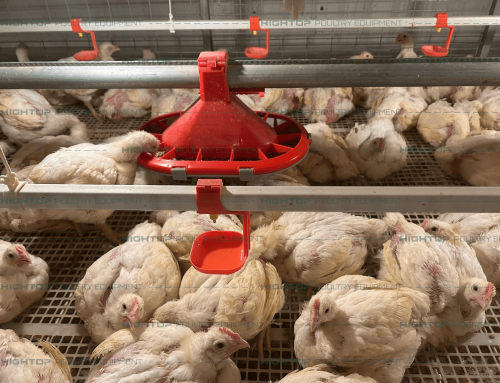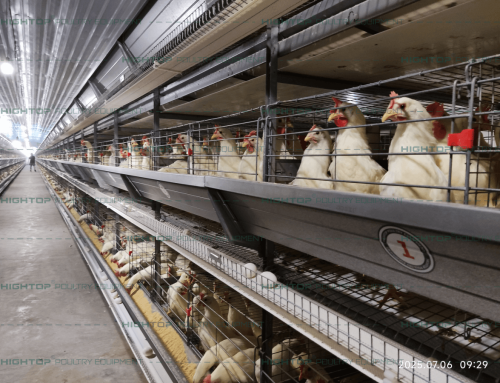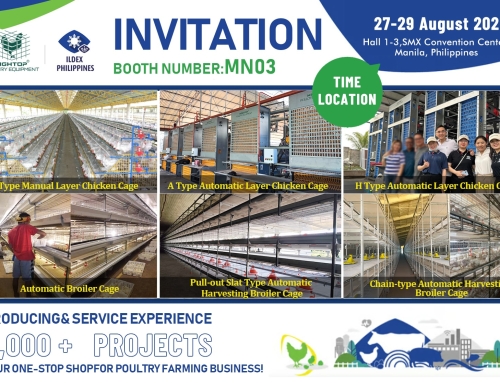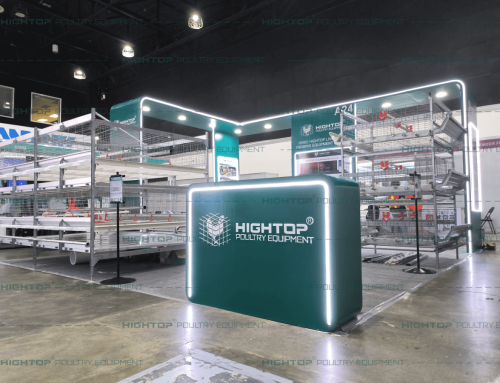Introduction
Modern commercial poultry farms increasingly favor steel-structure chicken houses. These prefabricated buildings offer a controlled environment for layer and broiler flocks, and can support automated feeding, egg collection, and climate control systems. In this article we examine advantages and disadvantages of steel-structured poultry barns – and explain how HIGHTOP’s prefab steel houses combine the best features to benefit poultry farmers and equipment buyers.
Advantages of Steel-Structure Chicken Houses
Rapid Construction and Installation: Prefab steel buildings are built off-site and bolted together on-site, greatly cutting construction time. For example, Allied Steel reports that many metal buildings can be erected in weeks rather than months – up to 30–50% faster than traditional methods. HIGHTOP Poultry Equipment notes that a prefab steel layer house can be assembled in only ~20 days, versus ~60 days for a comparable concrete house. The bolted connection design means “no welding or cutting required at site,” making assembly straightforward. Faster builds mean lower labor costs and quicker time to production.
High Strength and Durability: Steel frames deliver excellent load-bearing capacity and resistance to extreme weather. Compared to concrete, steel has higher tensile strength and better wind- and earthquake-resistance. Buildings can be engineered with portal steel frames and diagonal bracing to withstand local snow and wind loads. For example, steel roofs are often rated to carry heavy snow (e.g. 20–40 lb/ft²) when properly designed. This robustness improves safety and reduces damage risk during storms, earthquakes, or 50-year snow events. Because steel is lighter than masonry, foundations can be simpler (often just a column footing), further speeding construction.
Wide Clear Spans and Flexible Layout: Steel trusses can span large widths (30–50 meters or more) without interior columns. This clear-span design maximizes usable floor area and allows installation of modern automation: multi-tier cages, feeding lines, egg conveyors, and manure belts fit unimpeded across the barn. Wide spans and modular framing also allow farms to expand easily – sections can be added or reconfigured as operations grow. (Prefabricated steel farms can be fully customized in size and layout to fit any site.)
Long Service Life and Ease of Maintenance: Properly treated steel buildings last for decades with routine care. Hot-dip galvanized steel framing and high-quality paint coatings resist rust, so a steel poultry house can remain sound for 20–30 years or more. In fact, research notes that a coated steel structure typically survives 25–30 years on average. HIGHTOP Poultry Equipment specifies a galvanized frame with thick protective paint, giving its houses lifespans “more than 30 years”. Smooth metal panels and galvanized surfaces are also easier to clean and disinfect than porous materials, helping maintain sanitary conditions. Regular inspection and touch-up of any paint damage or rust spots is standard practice to ensure longevity.
Energy Efficiency and Climate Control: Modern steel houses can be designed with excellent insulation and ventilation. As the University of Georgia notes, controlling heat gain is critical: an uninsulated metal roof can reach 150°F (66°C) in sun, radiating heat into the barn. By using high-quality insulated panels and reflective roofing, steel buildings can keep interior temperatures steady. In fact, one farm supplier explains that prefab steel houses often provide better insulation and ventilation than wooden barns, maintaining comfortable conditions and reducing heating/cooling cost. Skylights and automated air-inlets (e.g. positive-pressure fans) are commonly integrated to ensure uniform light and airflow. With smart climate-control systems, a steel house can keep birds cooler in summer and warmer in winter, improving flock health and productivity.
Environmental and Biosecurity Benefits: Prefabricated steel construction uses less wood and brick, making it a greener choice. Steel farms can be fully enclosed and easily sealed against pests and predators. A tight, ventilated steel shell helps keep disease vectors out and makes it easier to control internal air quality and humidity. By contrast, open or porous wall materials allow drafts and vermin. Overall, steel buildings give farmers more control over the barn environment, aiding biosecurity and reducing losses from weather or contamination.
Disadvantages of Steel-Structure Chicken Houses
Higher Upfront Cost: Steel buildings generally require a larger initial investment. Engineering-grade steel and insulated sandwich panels cost more than simple wood or concrete. As one industry blog notes, “the construction cost of prefabricated steel structure chicken houses is higher” than traditional houses. Estimates vary by region, but farms should expect 20–30% higher capital cost for a steel barn than a basic masonry house. However, many producers find that the long-term benefits (durability, reusability, labor savings) offset this premium over time.
Corrosion Risk from Poultry Environment: Poultry houses contain corrosive gases. Ammonia and hydrogen sulfide (from manure) can attack steel, especially in humid conditions. Ziggity Farms reports that “the most noxious chemical created by a poultry operation is ammonia” and that ammonia “attacks metal components…including steel walls”. Ordinary painted steel panels can rust or perforate within a few years if left unprotected. Frequent cleaning and disinfectant use (especially chlorine-based agents) accelerates oxidation of metal surfaces. Left unchecked, corrosion can shorten a barn’s life and lead to structural weakness.
Thermal and Humidity Challenges: Uninsulated metal conducts heat and cold very quickly. In summer, a bare steel barn will heat up far more than a brick one. Auburn University research shows an uninsulated galvanized roof can hit 150°F (66°C) and radiate 30–35 BTU/hr·ft² of heat into the house. Without ample insulation and ventilation, interior temperatures in a steel house can run 5–8°C higher than outside. Conversely, in winter a poorly insulated steel barn loses heat rapidly – an uninsulated wall can leak ~27 BTU/hr·ft² with a 40°F temperature drop. This “cold-bridge” effect also causes condensation on cold surfaces. Poultry ventilation experts warn that if warm, moist air contacts a cold metal surface, “condensation will form”, leading to wet litter, dripping, and potential respiratory issues. In short, without careful insulation and sealing, steel houses can be drafty or prone to humidity spikes.
Power Dependence and Complexity: Steel poultry houses typically use automated fans, feed lines, lighting and climate systems that rely on electricity. A power outage or equipment failure can have an immediate impact on the flock. The complexity of ventilation and heating controls is higher than in simpler barns. In addition, erecting a steel building requires technical expertise and heavy machinery for lifting and bolting large trusses, whereas a wood or brick shed might be built more simply (though slower and less durable).
Mitigating Challenges: Best Practices
Modern steel poultry houses address most drawbacks through design and materials:
Anti-Corrosion Treatments: Use hot-dip galvanized steel framing (with at least 275 g/m² zinc coating) and high-performance paints. For example, a zinc-rich primer plus a thick polyurethane topcoat (total dry film ~200 µm) can protect against ammonia-rich air. Critical areas (column bases, fasteners) are encased or sealed to keep out moisture. Minimizing on-site welding also reduces rust points; bolted connections are easier to protect. Essentially, quality steel with robust coatings – as used by leading poultry-hardware suppliers – will resist the barn’s harsh chemistry and give decades of service.
Insulation and Sealing: Install insulated sandwich panels (polyurethane or polystyrene core) on walls and roof. In temperate or cold climates, at least 10 cm of foam paneling keeps heat in. All joints and penetrations should be foam-sealed and caulked to prevent air leaks. Internal vapor barriers or foil facings can stop moisture from reaching cold steel surfaces. Combined with pressure-controlled ventilation (e.g. maintaining slight negative pressure), these measures prevent condensation. As one poultry extension guide advises: “Metal end walls should always be insulated” to minimize condensation. Good design may also include attic or ceiling insulation (skylight panels instead of solid roof) to diffuse sunlight and reduce heat gain.
Climate Controls: Use automatic fans, evaporative cooling (drenchers), and heaters tied to thermostats and humidistats. Aim for air inlet speeds of 2–3 m/s so chickens have fresh air without direct drafts. Ensure ventilation rates meet or exceed recommendations (e.g. 0.1 m³/min per bird). In cold weather, heat is often provided by hot-water or hot-air systems. Research shows floor heating (using tubes under the litter) can be ~20% more efficient than air-forced heating in layer houses, keeping birds warm with less energy. Skylights and LED lighting reduce electricity use for light and improve bird well-being during the day.
Sanitary Design: Plan for manure removal and easy cleaning. In caged layer houses, automated belt systems quickly remove manure to an external pit or lagoon, reducing ammonia. Slope floors (≥3°) toward collection gutters. Where possible, use acid-resistant PVC paneling on interior walls (instead of bare painted steel) to withstand frequent washing and disinfecting. Maintenance routines should include quarterly inspections: sand and repaint any rust spots, check seal integrity, and clean fan filters and drinker nozzles.
By applying these practices, a steel chicken house can deliver its benefits with minimal downsides. (Many of these measures – galvanizing steel, using modern insulation, installing environmental controls – are standard for any high-performance poultry barn today.)
HIGHTOP Steel-Structure Chicken Houses
HIGHTOP Poultry Equipment prefab steel poultry houses are designed to capture all the advantages above while minimizing the drawbacks. HIGHTOP – with 20+ years in poultry equipment – offers turnkey steel-layer and broiler houses tailored to modern farms. Their buildings feature hot-dip galvanized frames with thick powder coatings and custom paint, engineered for local wind, snow and seismic loads. In practice, HIGHTOP notes that one of their steel layer houses can be assembled in about 20 days – just one-third of the ~60 days a conventional concrete house would take. The construction is “bolt-only” with no field welding, so farms save on labor and can start production sooner.
These buildings are fully customizable in span and layout to fit automated cage systems, feed lines, egg belts and manure lines. The wide-clear-span trusses (often >30m) allow unobstructed interiors. Every HIGHTOP project includes insulation panels and sealed joints to handle temperature and humidity. They also install ventilation controls, skylights (≥70% light transmission), and can integrate floor heating systems in cold regions. In short, HIGHTOP’s steel chicken houses have all the key strengths we’ve discussed: rapid construction, structural strength, wide-span flexibility, long service life, and energy-conscious design. The company emphasizes that their prefab barns meet local climate specs and come with a lifespan of 30+ years, thanks to robust materials and coatings.
For poultry farmers and equipment buyers looking to upgrade their layer-cage operations, a steel-structure building is a compelling option. HIGHTOP’s products combine the modern prefab advantages (speed, durability, adaptability) with full-service support. In addition to the steel house itself, HIGHTOP provides complete turnkey solutions – design, equipment (cages, feeders, climate systems), installation, and training. This means farms can modernize quickly without sacrificing reliability.
Steel-framed poultry houses offer huge benefits – faster builds, strong weather resistance, high-density layouts, and easy maintenance. The drawbacks (higher cost, corrosion risk, climate control needs) are real but controllable through design. HIGHTOP’s steel-structure chicken houses illustrate how to get “the best of both worlds”: they leverage prefabricated steel’s speed and strength, use high-quality galvanizing and insulation, and package everything in a turnkey farm solution. Poultry farmers and buyers should consider steel housing for large-scale, automated layer farms – and HIGHTOP is a proven supplier that delivers on the advantages described here




